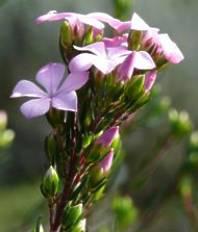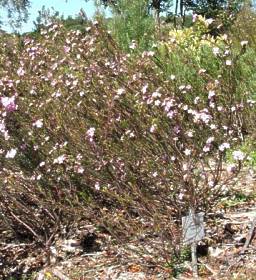Acmadenia trigona
Acmadenia trigona (Eckl. & Zeyh.) Druce
Family: Rutaceae
Common names: Langeberg porcelain flower (Eng.); Langeberg-boegoe (Afr.)
Introduction
Acmadenia trigona, from the winter rainfall region, forms an upright shrub with spreading branches. It grows 0.3-0.7 m high. It is a single stem at the base, branches are brown, smooth, hairless and leaf scars are visible. The younger branches are reddish. The needle-like leaves are green, erect, 8-15 x 1-1.5 mm, with oil glands.

Description
Description
During autumn, winter and spring this evergreen shrub bears deep pink flowers, 10-15 mm in diameter, brightening up the garden.

Flowers are borne in terminal clusters (4-8 flowers) or are solitary at the tips of the stems and in the axils of the highest leaves. Each of the flower's five petals has a noticeable dark pink nectar guide leading to the centre of the flower. The petals are pink, 8-10 x 4-6 mm, rounded and the underside of the petal is darker in colour.

The fruit is a capsule with 5 chambers, and each carpel contains one black shiny seed. The seed is 3-5 x 1.8 mm and ripens in November to December.
Conservation Status
Status
Not threatened.
Distribution and habitat
Distribution description
Acmadenia trigona is found growing on north-facing, dry, rocky, lower slopes of the Langeberg Mountains at an altitude of 300-700 m.
Derivation of name and historical aspects
History
The genus name Acmadenia is derived from the Greek word, akme, meaning highest point, and aden, meaning glands on the anthers. This refers to the conical gland at the apex of the anther, found in some species in this genus. There are 33 species in this genus and are mainly found in the southern and southwestern Cape. They are all found in the Fynbos Biome.
The first species of Acmadenia was described in 1781 as Diosma tetragona by Linnaeus' son. The genus name Acmadenia was proposed by Bartling and Wendle in 1824.
Ecology
Ecology
The capsule splits through drying and the seeds are forcibly discharged. This is known as ballistic dispersal. Ants collect the seeds, dispersing them away from the mother plant.
Insects, bees and butterflies are attracted to the flowering bush for its nectar and are responsible for pollination.
Uses
Use
Acmadenia trigona is an attractive evergreen shrub suitable for fynbos or water-wise gardens. Other interesting species are A. heterohylla, A. macropetala, A. mundiana and A. obtusata and are best used as a filler, border or accent plant in a mixed fynbos garden.

Growing Acmadenia trigona
Grow
Acmadenia trigona is small to medium and with its bushy growth and dark green leaves, it provides a texture contrast in a planting. It requires full sun and well-drained, alkaline to acid soil. Before planting, prepare the garden bed by digging over the soil, adding compost and a slow-release fertilizer.
Plant during autumn, winter and spring with a combination of Pelargonium, proteas, ericas, restios, watsonias, Leucadendron and other interesting companion plants. Water the garden area before planting. Plant out in groups of three or five, 20-30 cm apart, with enough space to encourage growth. Buchus respond to a fairly dense planting which helps to retain soil moisture. The rainy season allows buchus to establish themselves in the garden and to cope with drought and less water during summer. Once established, they will withstand a fair amount of frost. Plants can be maintained in the garden for several years and are pruned once the bush becomes untidy.
Plants require good watering in winter and moderate watering in summer. Do not allow plants to dry out and avoid cultivating the soil around the roots of these fynbos plants. They are slow-growing plants and should not be planted too close to faster growing plants. Add a layer of mulch after planting and annually to keep soil and roots cool in summer-the mulch retains soil moisture and reduces germination of weed seed.
Acmadenia trigona can be propagated by sowing seed and by taking cuttings.
Collect seeds from the current year's capsules. Harvest the seeds after the first capsule has opened and place them in a closed paper bag or closed container (not plastic). Store it in a warm and dry place. You can hear the seed being expelled from the ripening capsule.
The optimum time for sowing is during autumn. Clean seeds and sow on a prepared medium of sand and compost in equal parts in a seed tray. Cover seeds with a thin layer of bark and water. Place seed trays in a covered area with good light and ventilation. Keep seed trays damp and germination will take place within one to two months. Prick out seedlings when four true leaves have developed. Take care not to damage the fine roots. Harden off the seedlings in shade for 3 to 4 weeks before placing them in the sun. Pinch out the growing tips of seedlings to encourage bushy growth. Feed buchus regularly with a balanced nutrient.
The yellowing of leaves can be treated with an application of iron chelate. After 8 to 9 months, the plants can be planted out in the garden.

Cuttings are done from August to early October when suitable material is produced after flowering. Cuttings have the advantage of producing a larger flowering plant more rapidly than seedlings. Take heel- and semi-hardwood cuttings, 50-70 mm long, from the current year's growth. Prepare cuttings by making a clean cut below the node and remove a third of the foliage. Dip the base of the cuttings in a rooting hormone. Firmly place the cuttings in a medium of 50 % bark and 50 % polystyrene. Ideally, these cuttings should now be placed in an well-aerated propagation unit with a bottom heat of 24° C. Rooting should occur in 9-11 weeks. Carefully pot the rooted cuttings, using a well-drained, humus-rich, fynbos potting medium (2 parts leaf mould, 1 part coarse sand). Keep plants under shade for three weeks to harden off before being placed in the sun. Plants will be ready for planting in 7-8 months. Pinch back young buchu plants to encourage bushy growth. Once established, do not cultivate the soil around the root area.
Feed regularly with a well-balanced nutrient. Phytophthora cinnamonni, a soil and water-borne fungus, attacks the roots of most fynbos species. High soil temperatures promote the growth of this fungus, attacking the plant's root system. It prevents the uptake of water, causing plants to die. Remove infected plants and use soil mulch to reduce the soil temperature. Disturb the soil as little as possible. Treat plants with a fungicide prior to planting out. This is a precautionary measure to control the fungus and to protect adjacent plants.
References
- Brown, N. & Duncan, G. 2006. Grow fynbos plants. Kirstenbosch Gardening Series. SANBI, Cape Town.
- Gold, M. 1992. The buchus: cultivation and propagation. National Botanical Institute, Kirstenbosch.
- Goldblatt, P. & Mannning, J. 2000. Cape plants. A conspectus of the Cape flora of South Africa. Strelitzia 9. National Botanical Institute, Pretoria & Missouri Botanical Garden, St Louis.
- Manning, J. 2007. Field guide to Fynbos. Struik, Cape Town.
Credits
Norma Lucas
Kirstenbosch National Botanical Garden
August 2008
Plant Attributes:
Plant Type: Shrub
SA Distribution: Western Cape
Soil type: Sandy
Flowering season: Spring, Early Summer
PH: Acid
Flower colour: Pink
Aspect: Full Sun
Gardening skill: Challenging
Special Features:
Horticultural zones








Rate this article
Article well written and informative
Rate this plant
Is this an interesting plant?
Login to add your Comment
Back to topNot registered yet? Click here to register.